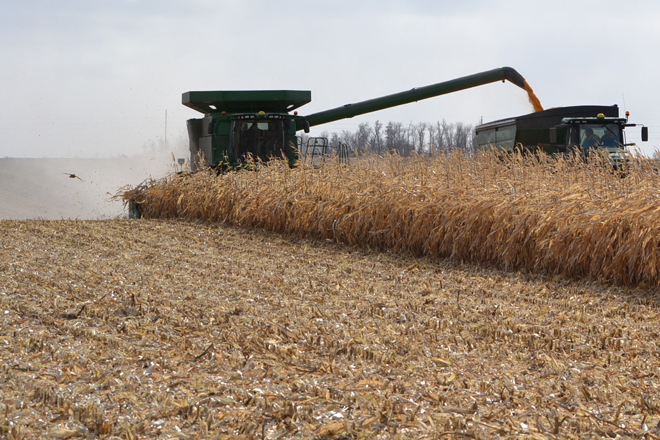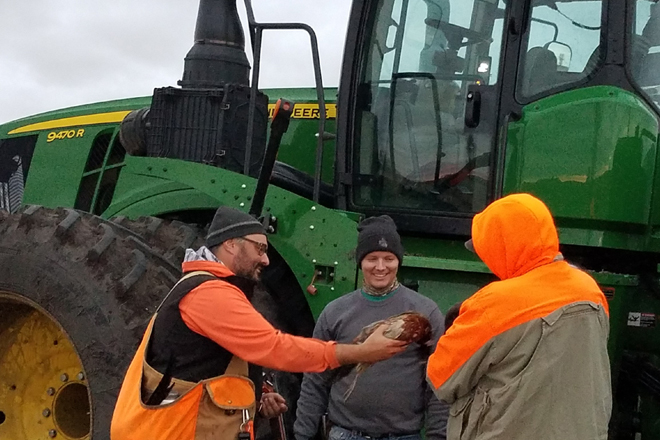This Rooster Road Trip guest blog is written by Tanner Bruse, Ag & Conservation Program Manager in MN with Pheasants Forever
In Southwest Minnesota fall is a time for anticipation in the field. After all, Minnesota DNR reported a 146% increase in Pheasant numbers for Southwest MN from their roadside count and we had the best weather and field conditions for planting and harvest in recent memory.
Take a drive down a gravel road in the evening this time of year and you will see a harvest haze that makes for some of the best sunsets you will find sinking behind a field of native grasses. This is the golden hour. Sitting behind the steering wheel of a John Deere combine, the farmer takes the last row of corn smiling at the final flush of a variety of wildlife that called the field home for the last 4+ months.
It is this connection to the land, the season and the harvest that ruffles excitement in rural Minnesota and builds lasting friendships and memories. Many of my friends and acquaintances that farm or work in the ag industry cheers to the end of harvest as they put on their blaze orange cap to pursue another passion, hunting. These same individuals also volunteer for local Pheasants Forever chapters and attend local fund-raising events such as PF banquets. The gravel roads connect rural Minnesota and the shared appreciation we have for our outdoors.
Pheasants are grassland and agriculture dependent species. The right mix of cropland and prairie provide the recipe for high populations topped with a sprinkle of good nesting and winter weather conditions. The one variable that is controllable is habitat and habitat quality. Habitat comes in all shapes and sizes including public land and voluntary private lands conservation. Another key component is the management activities that occur on these acres to keep them productive and resilient for wildlife production.

Farmers and landowners play an instrumental role in the creation of habitat and healthy wildlife populations. Lets take a walk through a few of the various programs that farmers implement that provide habitat opportunity for all wildlife.
Many farmers start by working through their local field offices comprised of Soil and Water Conservation Districts (SWCD), USDA Natural Resources Conservation Service (NRCS) and Farm Service Agency (FSA) who provide technical and financial assistance for voluntary conservation programs. This ranges from short term contracts such as the Environmental Quality Incentives Program (EQIP) to 10-15 year contracts of one of the most recognized programs in the Farm Bill, the Conservation Reserve Program (CRP).
On top of various shorter-term programs another popular decision made by landowners is the enrollment into conservation easements through State Agencies, Federal Agencies and NGO’s.
The combination of water quality, soil health and wildlife habitat are implemented through the Minnesota Department of Agriculture with a wildlife endorsement through the Minnesota Ag Water Quality Certification program.
Last but not least, I would consider Walk-In Access (WIA) to be the icing on the cake. WIA opens a whole new door to private lands voluntary conservation by allowing public access to take a stroll through the grasslands with their bird dog in pursuit of the flush. This opportunity is made possible through the United States Department of Agriculture (USDA), the MN Department of Natural Resources (DNR), and the landowner.
Talk about collaboration and partnerships for a shared vision and appreciation of the outdoors.
Pheasants Forever is involved in all of these capacities working with fantastic partners. This is done through various aspects of the organization. Our
Farm Bill Biologist program puts boots on the ground to assist landowners navigate the voluntary conservation programs available to them. Our
Precision Ag and Conservation Specialists are in the field with growers using technology and return on investment to identify acres that conservation might help fit the bill rather than traditional row crops. Our grass-roots chapter efforts and tireless volunteers are making a difference in the community and showcasing what can be accomplished together.

This fall I have a challenge for everyone hitting the gravel roads. Take the time to pull to the side of the road to let a farmer pass by with their equipment. Give them a wave as they pass by and if you have the time, spark up a conversation with them at the coffee shop. Be respectful of their land, ask permission and thank them for the opportunity to access. Together we make rural areas great by living a rural lifestyle and a shared appreciation and connection to the outdoors.
Have fun, be safe and shoot straight this fall!
Tanner works in Minnesota with private lands voluntary conservation programs, assists with PF’s Precision Ag Initiative and manages a talented team of twenty individuals working directly with farmers to improve profitability and implement conservation practices. Tanner obtained his Bachelor of Science degree in Wildlife and Fisheries from South Dakota State University. He grew up in SW Minnesota, one of his fondest memories is chasing livestock to the auction ring at the sale barn his grandfather owned, SW MN Livestock in Worthington, MN. In addition to having roots in Agriculture he also developed a passion for spending time outdoors with his father hunting and fishing. Tanner, his wife Heather and two sons Beau and Wyatt live near Camden State Park on a couple of acres “in the valley” of Lynd Minnesota raising chickens and two dogs.
Follow Pheasants Forever’s Rooster Road Trip online at:
Facebook /
Twitter /
Instagram /
Podcast /
Rooster Road Trip web page
Rooster Road Trip 2020 Sponsors:
Sincerest thanks to our partners riding shotgun:
Apple Autos,
Browning,
Federal Premium Ammunition,
Garmin,
Ruff Land Kennels,
SoundGear,
#ResponsibleRecreation